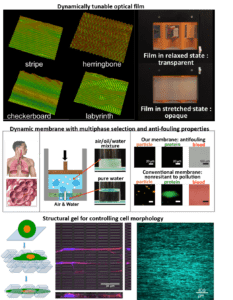The research of our group focuses on Soft Active Materials especially those consisting both solid and liquid. Our research is at the interface between mechanics and materials chemistry. Our studies span from fundamental mechanics to novel applications. We take integrated approach of experiment and theory. The current stage of our research includes: (1) chemomechanical modeling of soft materials (2) multi-scale mechanical characterization of soft materials, and (3) design and fabrication of new dynamic adaptive multi-functional materials for various applications. With the tools and knowledge generated from these studies, we also explore the phenomenologically similar but structurally more complex nature soft living systems, such as cells, tissues and organs.
1. Chemomechanics of soft materials
For centuries, nature has awed scientists with its rich repertoire of materials and systems that can reversibly adjust their structure and properties in response to environmental stimuli. In sharp contrast, nearly all traditional man-made materials are static in both form and function, and only quite recently are synthetic materials chemists gradually shifting their attention to dynamic materials, which has led to unprecedented capabilities in engineering materials such as autonomous actuation and sensing, controlled release, self-healing, self-regulation, self-reporting, self-cleaning, anti-fouling, and adaptive optical properties. Among many reconfigurable and responsive materials, gels have been in the center stage of research in recent decades. Gels are cross-linked polymer network swollen in an aqueous solution. They are both solid like and liquid like: the polymer matrix can support load and retain shape, and the pores in the matrix are interconnected, and the fluid can flow through the network. The aqueous nature of the material provides an ideal media for coupling with chemical reactions. By incorporating into the network with functional groups that can change the interaction properties with the surrounding liquid and ions in response to stimuli, the gels were made responsive and reconfigurable to temperature, pH, electric field, light etc. In our group, we explore the multiphysics-coupled large deformation of gels.

2. Multi-scale mechanical characterization of soft materials
Fundamental studies of the time-dependent deformation and failure mechanisms of soft materials as well as optimal designs in applications require robust methods for material characterization. However, mechanical testing on soft gels is practically challenging. The typical modulus of gels is in the order of 1~102 kPa, which is more than 6 orders of magnitude lower than metals, and 3 orders of magnitude lower than plastics. Additionally, some gels are saggy, brittle, slippery, and need to be kept hydrated during testing, which raise many difficulties in experiments. In this group, we aim to provide easy and robust theoretical solutions as well as experimental protocols for characterizing soft materials. We also quantitatively study the structure-property relation of soft gels.

3. New multi-functional soft materials
Conventional engineered systems with dynamic adaptive responses often rely on materials with specific chemical properties that undergo phase transitions at the atomic/molecular scale to enable macroscopic dynamic behavior in the form of piezoelectric, pyroelectric, electrochromic, shape memory effect and so on. The limited availability of these specific chemical compounds that undergo the atomic/molecular transitions is a major constraint. Our search for new dynamic adaptive materials has to go beyond the traditional route. Different from conventional engineering approach that relies on calving, molding, extruding, rolling, weaving and 3D-printing of solid materials, Mother Nature appears to ubiquitously and seamlessly assemble both liquid and solid components together to create dynamic systems with exquisite tunability, fast responsiveness, and robust self-adaptability. Liquid with its ability to flow and reconfigure is an ideal component for responsiveness. When integrated into an intricate underworld of the molecular network or micro-/nano-porous skeleton, the liquid can be stably locked in space, generating stable and shapeable materials. Our work on developing new dynamic multi-functional materials is based on this liquid-solid hybrid platform. The hybrid system allows for harnessing broad combinational potentials among various inputs and outputs and enable a versatile strategy for expanding the dynamic responsive repertoire. The half-solid and half-liquid nature of the system also provides a flexible platform to couple mechanics with chemistry. Based on this platform, we design and fabricate new advanced materials for a broad range of applications, e.g. energy conversion, tunable optics, oil repellents, actuation, anti-fouling, and so on.


